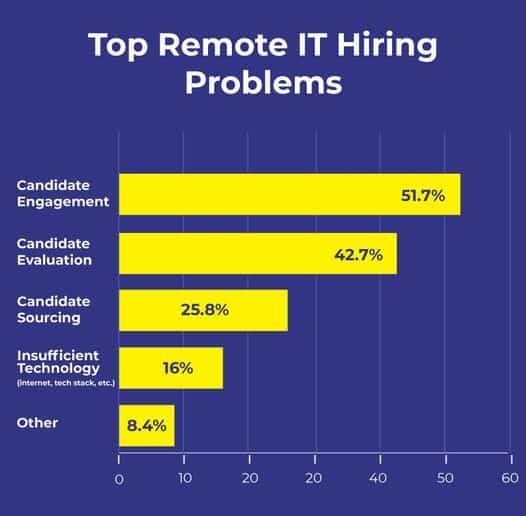Scholars tout the era we live in today as the Age of Information. This is because the economy has witnessed a marked shift in the last century alone in the Information Technology (IT) sector. Nations have gone from manufacturing, as their primary economic activity, to IT services contributing a majority to their GVAs.
The COVID-19 pandemic has defined a new way of conducting business. Owing to the implications of Social Distancing, remote workspaces emerged. What started as an unfortunate alternative, quickly rose to prominence because of its unfolding benefits. Corporations soon realized the costs they could cut back on in logistics- establishment, travel, accommodation, etc.
The increasing reliance on digital technologies has resulted in any job to be affected by IT. This, along with mushrooming remote work opportunities, has made the process of hiring and onboarding complicated for IT employers.

In this blog, we take a deep dive into those problems and come ashore with effective solutions.
- Too many vacancies- too little relevant applications
As an employer, understanding the latest job seeking trends are extremely important. With remote jobs on the high, the process of seeking those are also becoming increasingly digitised. Media like LinkedIn, Monster, Indeed, etc. have made it extremely handy for jobseekers to view and “Easy Apply” to “related jobs.”
What this does is create too many vacancies, especially for various IT services. A beginner’s competitor analysis can be extremely useful in informing us about the number of vacancies in the market for the same job profile. This hikes up the number of job applications you receive from candidates looking for similar- but not the exact same- job roles.
The solution: While you cannot do much about the number of vacancies in the job market, you can certainly control the number of applications you receive. All you have to do is write comprehensive job descriptions mentioning exact skills you are looking for. It will allow you to fetch the right applicants and minimize the hassle of going through thousands of CVs.
Many companies provide cost-effective 360-degree remote staffing solutions. Outsourcing to them would also be timesaving, especially if you are a start-up or SMB, with already a lot on your plate.
- Logistics of Hiring, Onboarding and Training
In most cases, virtual work entails a virtual hiring process, too. Unlike face-to-face job interviews, here the employer is not privy to the candidates’ non-verbal communication. Sure, they can see the interviewee through video-calling meeting apps like Zoom and Google Meet, but it does not quite capture the authenticity of in-person interviews. Not to mention, a business-owner might not know the right places to look to hire IT employees, to begin with.
There may also be communication gaps within the hiring team or the different departments of the organization itself. This can further complicate collaboration with the candidate, who is unfamiliar with the company, at this stage. Further, the new hire, may find it to be daunting to get acclimatized to the new business processes, which can make the training process overwhelming for the remote employer.
The solution: Creating a hassle-free Hiring, Onboarding and Training process can be difficult if not left to professionals. Skilled teams of HR professionals have at their disposal latest strategies and updated best industry practices for talent acquisition. Especially when it comes to remote hiring, professional expertise saves not only money, but also precious time, while providing you access to a large and diverse talent pool.
- Engagement in Company culture
Numerous studies have shown how the remote workspace has led to feelings of isolation among remote employees. This can be even more stark in the case of new hires, who not only have to deal with a new work mode, but also a new work culture. Difficulty in understanding and settling into the new company is amplified by the inability to meet colleagues in person.
An inconvenient and uneasy adjustment into this process can be a sure recipe for disaster when it comes to yielding business solutions. This affects not only the individual employee, but the entire office mood, by extension. It can also lead to losing out on potential clients. This, ultimately, results in a lowered business productivity and revenue generation.
The solution: Creating immersive virtual experiences- like real-time multiplayer games- for your remote employees can help build trust. Effectively executing engaging team building exercises not only lays the foundation for acquiescing, but also fosters easy communication, by breaking down its barriers. It sustains a conducive environment for daily business needs.
You can make the experience even more engaging by letting your remote employees chime in recreational activities they would like to do together!
Remote Resource – A one-stop solution to Remote IT Hiring Problems
According to an article by Forbes, the pros of remote hiring far outweighs its cons. Many popular multi-national corporations, like Meta, Amazon, Apple, Google, etc., have international employees.
Recently, Elon Musk announced his plans to “decentralize” Twitter by hiring from India.
Although offshoring and remote outsourcing are not quite same logistically- the former involves significant establishment costs- they are based on the same business conduction models. That is, both are built around the idea of cost cutting, but not at the expense of professional, solutions-driven skillset. For SMBs, without the budget of MNCs, looking to expand their business in a time-bound manner, outsourcing the bulk of their IT services is the only futuristic solution.
We, at Remote Resource, understand the need for highly skilled IT employees for a growing business. So, we only process pre-vetted CVs of the top 10% of Indian talent, with mandatory work experiences from Fortune 500 companies. Book Free Consultation to learn more about how we are helping SMBs find reliable remote IT employees for them.


